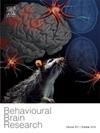比较神经反馈和经颅电刺激对健康成年人运动学习的短期和长期影响。
IF 2.6
3区 心理学
Q2 BEHAVIORAL SCIENCES
引用次数: 0
摘要
研究人员正在探索经颅直流电刺激(tDCS)和神经反馈(NFB)等非侵入性神经调节技术,以提高运动学习能力。经颅直流电刺激(tDCS)利用外源性电场调节大脑兴奋性,而神经反馈(NFB)则是一种内源性大脑刺激技术,可使个体在闭环系统中调节大脑兴奋性。尽管它们的机制不同,但目前还缺乏直接比较它们对运动学习影响的研究。本研究旨在比较 tDCS 和 NFB 对健康参与者的在线学习、短期离线学习和长期离线学习的影响,从而找出增强运动学习能力的最有效方法。在这项平行、随机、单盲、对照试验中,100 名健康参与者被随机分配到五组中的一组:真实 tDCS 组、假 tDCS 组、真实 NFB 组、假 NFB 组和被动对照组。主要结果包括归一化反应时间 (NRT)、归一化反应准确性 (NRA) 和归一化技能指数 (NSI),通过连续反应时间任务进行测量。次要结果包括身体和精神疲劳度,使用视觉模拟量表进行评估。研究包括 14 个区块,每个区块 80 次试验。在线学习通过第 3 块和第 9 块之间 NRT、NRA 和 NSI 的变化进行评估。短期和长期离线学习分别通过第 9 块和第 11 块之间以及第 9 块和第 13 块之间这些指标的变化进行评估。结果:结果显示,从第 3 到第 9 个区段,假 tDCS 组和被动对照组的 NRA 显著下降,其他组没有变化。从区段 9 到区段 11,所有干预组的 NRT 都明显下降,对照组没有变化。从第 9 到第 11 个区段,所有干预组的 NSI 都有明显增加,效应量从大到非常大,而被动对照组的效应量增加幅度为中等。此外,从第 9 个区段到第 13 个区段,真实 NFB 和真实 tDCS 组的 NRA 显著增加。将第 13 个区段与第 9 个区段相比,所有干预组的 NRT 也明显下降,而被动对照组则无明显变化。值得注意的是,从区块 9 到区块 13,真实 tDCS 组的 NRT 下降幅度明显大于对照组,平均差异为 0.087(95% CI:0.004-0.169,p = 0.031)。此外,除对照组外,所有干预组的 NSI 从第 9 个区段到第 13 个区段都明显增加。总之,NFB 和 tDCS 对在线学习都没有明显的积极影响。然而,tDCS 和 NFB 的真实和虚假版本都明显改善了短期离线学习。NFB和tDCS之间以及真实干预和假干预之间的改善差异在统计学上并不显著,这表明安慰剂效应可能在促进短期离线学习方面发挥了重要作用。对于长期离线学习,两种脑刺激方法,尤其是 tDCS,都显示出了积极的效果,尽管安慰剂效应似乎也起到了一定的作用。本文章由计算机程序翻译,如有差异,请以英文原文为准。
Comparison of short- and long-term effects of neurofeedback and transcranial electrical stimulation on the motor learning in healthy adults
Researchers are exploring non-invasive neuromodulation techniques like transcranial direct current stimulation (tDCS) and neurofeedback (NFB) for enhancing motor learning. While tDCS modulates brain excitability using exogenous electric fields, NFB is an endogenous brain stimulation technique that enables individuals to regulate brain excitability in a closed-loop system. Despite their differing mechanisms, a direct comparison of their effects on motor learning is lacking. This study aimed to compare tDCS and NFB on online learning, short-term offline learning, and long-term offline learning in healthy participants, seeking to identify the most effective method for motor learning enhancement. In this parallel, randomized, single-blinded, controlled trial, 100 healthy participants were randomly assigned to one of five groups: real tDCS, sham tDCS, real NFB, sham NFB, and passive control. Primary outcomes included normalized reaction time (NRT), normalized response accuracy (NRA), and normalized skill index (NSI), measured through a serial reaction time task. Secondary outcomes involved physical and mental fatigue, assessed using a visual analog scale. The study involved 14 blocks of 80 trials each. Online learning was assessed by changes in NRT, NRA, and NSI between Block 3 and Block 9. Short-term and long-term offline learning were evaluated by changes in these measures between Block 9 and Block 11, and between Block 9 and Block 13, respectively.
Results
showed a significant decrease in NRA in the sham tDCS and passive control groups from block 3–9, with no changes in other groups. NRT significantly decreased in all intervention groups from block 9–11, with no change in the control group. The NSI significantly increased across all intervention groups between blocks 9 and 11, with large to very large effect sizes, while the passive control group saw a medium effect size increase. Furthermore, NRA significantly increased in the real NFB and real tDCS groups from block 9 to block 13. NRT also significantly decreased in all intervention groups when comparing block 13 to block 9, while the passive control group showed no significant changes. Notably, the reduction in NRT from block 9 to block 13 was significantly greater in the real tDCS group than in the control group, with a mean difference of 0.087 (95 % CI: 0.004–0.169, p = 0.031). Additionally, NSI significantly increased in all intervention groups except the control group from block 9 to block 13.
In conclusion, neither NFB nor tDCS had a significant positive impact on online learning. However, both real and sham versions of tDCS and NFB resulted in notable improvements in short-term offline learning. The difference in improvement between NFB and tDCS, as well as between real and sham interventions, was not statistically significant, suggesting that the placebo effect may play a significant role in enhancing short-term offline learning. For long-term offline learning, both brain stimulation methods, particularly tDCS, showed positive effects, although the placebo effect also appeared to contribute.
求助全文
通过发布文献求助,成功后即可免费获取论文全文。
去求助
来源期刊

Behavioural Brain Research
医学-行为科学
CiteScore
5.60
自引率
0.00%
发文量
383
审稿时长
61 days
期刊介绍:
Behavioural Brain Research is an international, interdisciplinary journal dedicated to the publication of articles in the field of behavioural neuroscience, broadly defined. Contributions from the entire range of disciplines that comprise the neurosciences, behavioural sciences or cognitive sciences are appropriate, as long as the goal is to delineate the neural mechanisms underlying behaviour. Thus, studies may range from neurophysiological, neuroanatomical, neurochemical or neuropharmacological analysis of brain-behaviour relations, including the use of molecular genetic or behavioural genetic approaches, to studies that involve the use of brain imaging techniques, to neuroethological studies. Reports of original research, of major methodological advances, or of novel conceptual approaches are all encouraged. The journal will also consider critical reviews on selected topics.
 求助内容:
求助内容: 应助结果提醒方式:
应助结果提醒方式:


